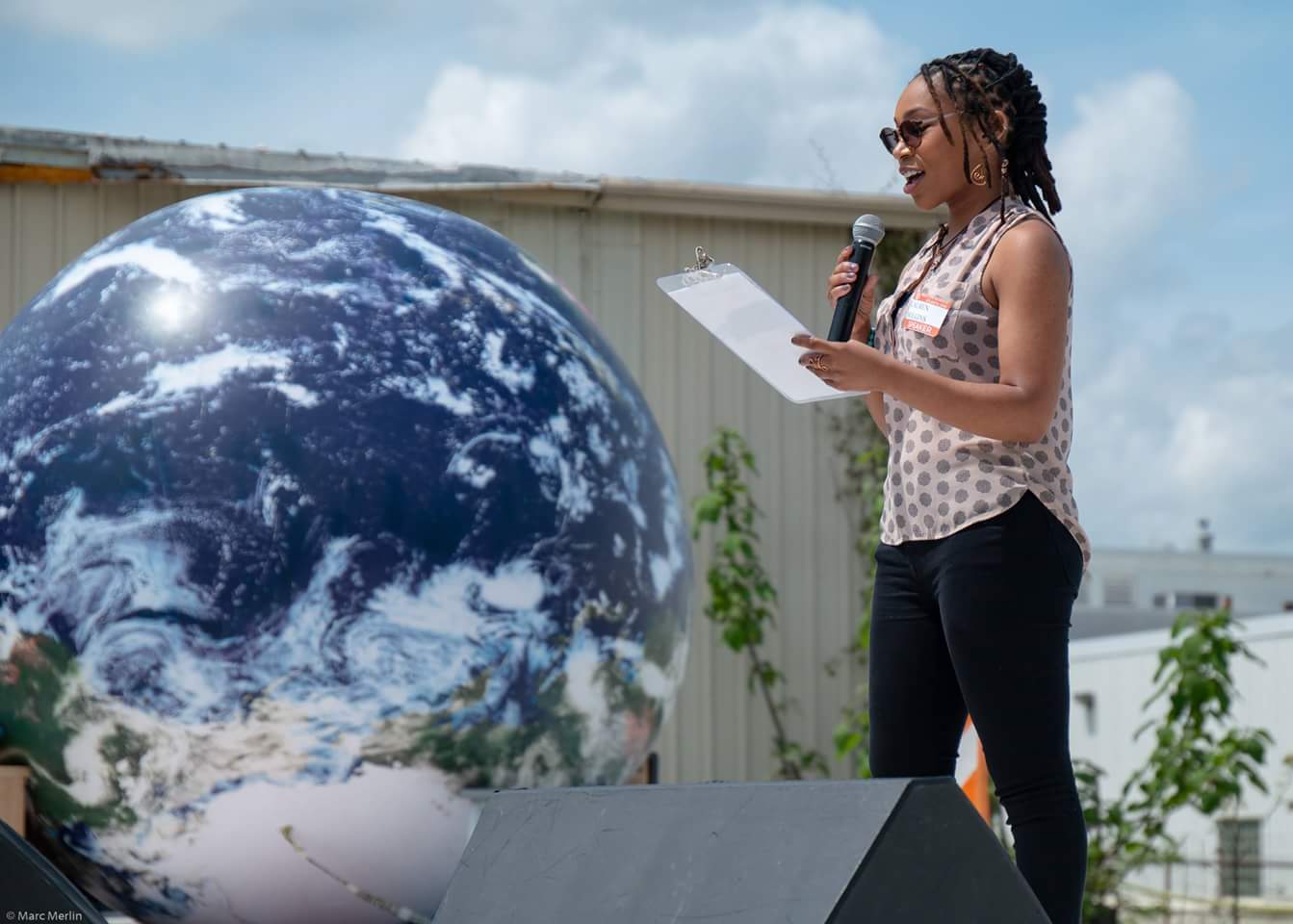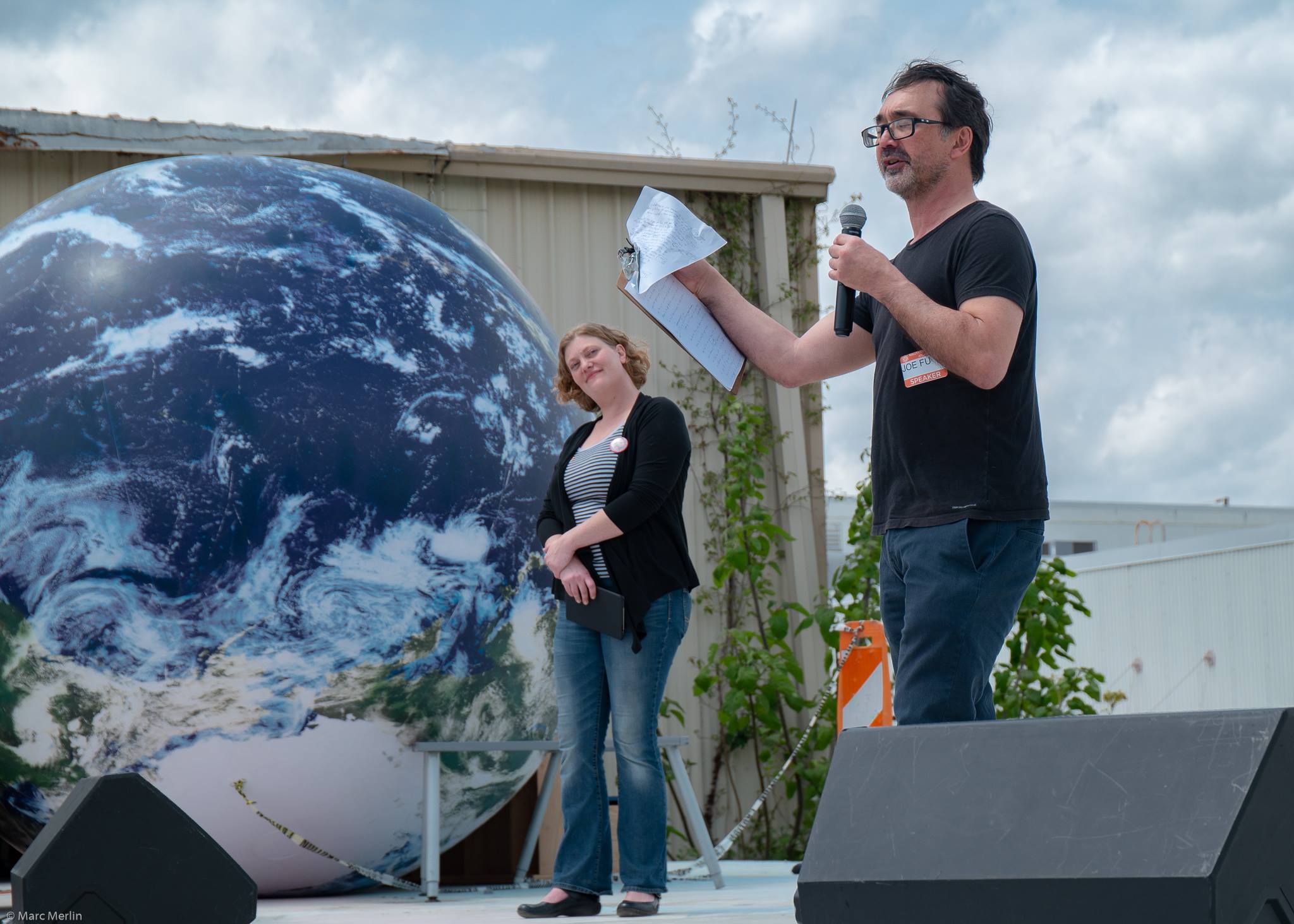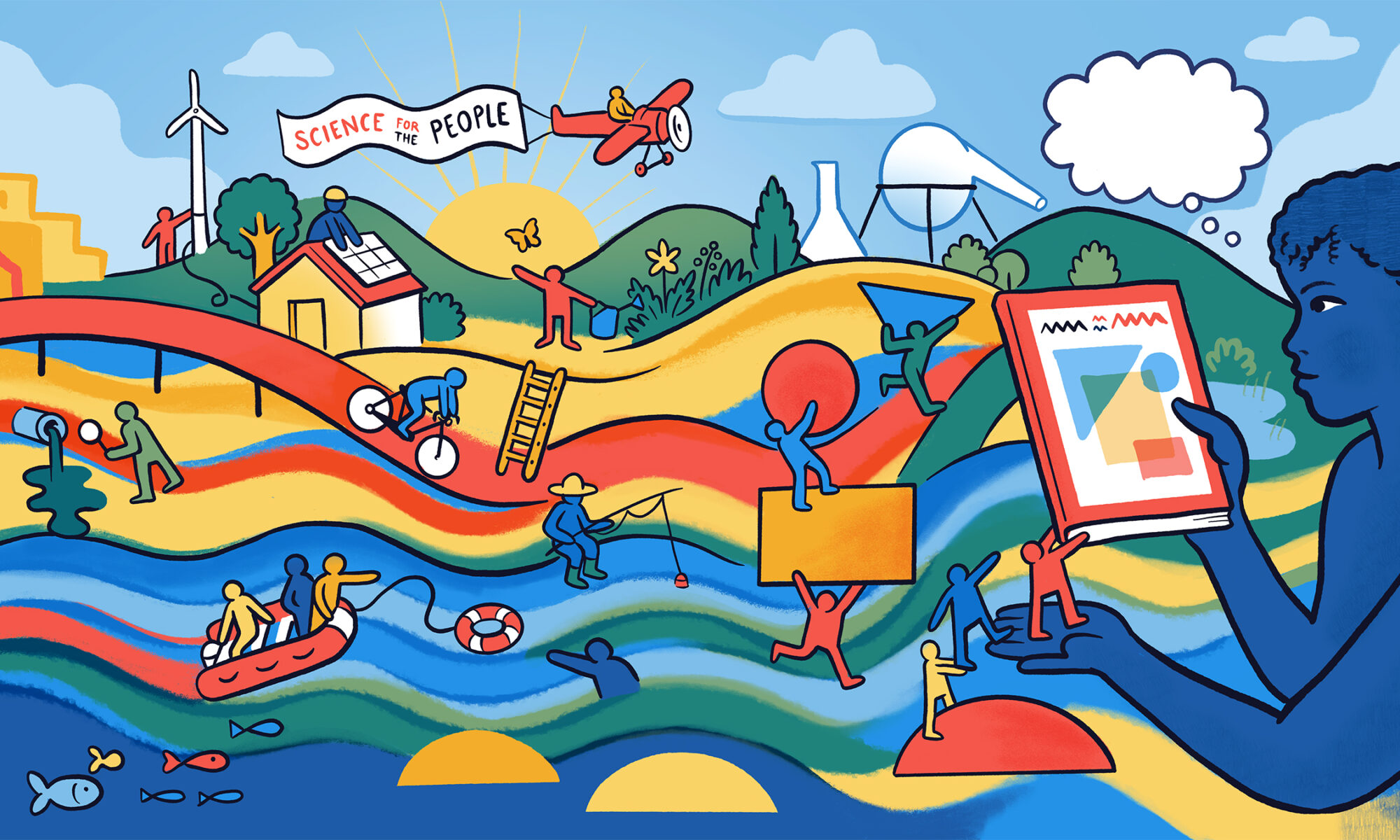The following two speeches were presented by members of Science for the People’s Atlanta chapter, Lauren Wiggins and Rebekah Ward, at their local March for Science on April 14, 2018. Click here to see photos and read reports on Science for the People organizing at the March for Science in the U.S. and Mexico.
Lauren Wiggins:
Good Afternoon! My name is Lauren, and I am here representing the Atlanta Chapter of Science for the People at the 2018 Rally for Science and I’m excited to be here with you all today! And today I’m going to talk about climate change, big business, and social justice.

My first introduction to climate change was in 2014. I was an intern for Greenpeace–you may have heard of it. At the time, I wasn’t aware of the influence they’d had on society since the 1970s, nor was I aware of their current status as the largest global environmental organization. Truth be told, I’d just heard of the idea of climate change a few months prior to getting the internship. I’d heard of climate change from a friend in my junior year of college. I read a few articles, joined a sustainability group, and attended a conference or two on climate science and activism, and at that point I really thought I’d found my passion…but while I was interning at the Greenpeace USA headquarters, I stumbled upon an article about people who are trafficked into forced labor in the fishing industry. I was absolutely blown away, and wondered why this aspect of sustainability wasn’t more widely publicized along with the “save the whales” marketing Greenpeace had used for decades.
But I’m not here to talk about what lead me to my passion, I’m here to open your minds to what wasn’t taught to me as a school-aged child: climate change and social responsibility.
Most of us here have heard plenty about the environmental movement. We all support it and I’m sure I don’t need to stand here and convince you all that climate change is real, but what I will do is convince you that there’s a neglected narrative in the green movement. While we focus on campaigns to save the polar bears, the Sumatran tigers, the green sea turtles and other species that are undoubtedly worth saving: We often leave the most under-resourced and marginalized communities behind in this movement. It always baffles me to see large environmental campaigns driven by the concern of species far outside our own, but when we think about the human beings–you know, our neighbors, our community members, those who look like and reflect us–who in this instance, live less than ten miles from us, we often have no remorse for their circumstances or surroundings, or concern for their well-being.
In the midst of these changes in climate, the world often forgets to acknowledge that those who are producing most of the pollutants that are harmful to our health and our atmosphere are those farthest away from enduring the consequences of climate change. I cannot stress enough that the poor, and people of color, have always been and will continue to be the first affected and worst affected by natural disasters that are fueled by climate change. An example of this has been widely noted with Hurricane Katrina, a tragedy that displaced almost half a million people. I must emphasize that there are powers who are benefitting from these natural disasters. Naomi Klein, a Canadian journalist, author, and social activist, termed this consequence perfectly as “disaster capitalism.” She says, “some stockpile canned goods and water in preparation for major disasters, [while others] stockpile free-market ideas,” such as privatizing public services and corporate buyouts of low-income housing.
So those of us here probably aren’t looking for the next opportunity to build a beachside resort the next time a typhoon hits (which, by the way, is what happened in the Philippines following the Typhoon Haiyan disaster–and if you’ve been following the news, a similar cycle of exploitation is happening in Puerto Rico), but do consider this: When another natural disaster hits our world, the people who possess the means to do so will simply evacuate and reconstruct it without concern for those whose lives have been uprooted and whose families have been torn apart. However, the communities that were disenfranchised way before a disaster comes along will not have that option, and there are capitalists who bank on that occurrence (pun intended).
In one of my favorite books, Warriors of the Rainbow: A Chronicle of the Greenpeace Movement, author Robert Hunter writes, “A small group of people, acting imaginatively and nonviolently, can affect the course of events in our global village.” And this is true! Small groups are the seed of any movement! And if that small group is determined to change society to everyone’s benefit, it can make the largest impact!
I am an activist by trade, and by recreation. I volunteer with a group called Science for the People. We’re a group of scientists who, in 1969, were key in debunking the myths surrounding race and genes. Well-known figures like Stephen Jay Gould and Richard Lewontin started our organization! Our pamphlet’s title, “The Dual Nature of Science,” which you can find at our booth is inspired by yet another influential scientist, Richard Levins.
We are revamping Science for the People now, in the 21st century, because we believe that Science IS for the People, not for profit! We believe that Science IS for the People, not for war! We work on demilitarizing science, we work on making science accessible, and we work with communities because science is key for policy-making and transparency!
Science for the People works with the Atlanta community to make sure that our city is fueled by 100% clean energy, as the city council has promised in their recent resolution. Our vision for a 100% clean city, and ultimately a carbon-neutral world, is where clean energy develops alongside increased equity. So I urge you all to join us or join another organization that actively helps with this ambitious plan that can make our future more equitable, more sustainable, and more harmonious!
In the words of Dr. Martin Luther King, Jr., “it really boils down to this: that all life is interrelated. We are all caught in an inescapable network of mutuality, tied into a single garment of destiny. Whatever affects one destiny, affects all indirectly.”
My life’s work is centered around justice for the environment and primarily the marginalized communities that have been oppressed, exploited, and constantly overlooked by the structures that, if they chose to, could “save” these communities. But I’ve come to a powerful realization in my years of organizing: we can’t wait around for anything to save us. One of my favorite idioms is, “If you want something done right, do it yourself.” To be clear, I don’t intend to save the world by myself, nor would I suggest that the task be taken on by a single organization, because history has shown us that no movement reaches success by uniform assembly, but rather a diverse collective of shared power and respected values. We have to work alongside our communities, and at the same time, provide them with the tools and support to liberate themselves, as Science for the People is poised to do in this nation and eventually around the world.
After my first Black Lives Matter action and other environmental justice engagements at the United Nations climate talks, I declared to myself–and now to all of you–that I would spark a fire in each person I have the pleasure of meeting; so I want to spark the fire of empowerment in you, and you, and you…I want you all to join a movement and uplift a cause that is outside of yourself, your culture, and your upbringing. Like I said earlier, we all share this earth, and each of you in this audience possesses an invincible power to change the way humans live in it and among each other.
Thanks for listening, y’all.
Rebekah Ward:
There is a context to the current attack on science, and science education specifically. The first year Congress actually made specific appropriations for science education was 1958, one year after Sputnik was launched. What’s of note here is that it took the Cold War to motivate our government to take science education seriously. Previously, and historically, science had been the domain of the few and privileged. But that began to change during the 1960s and ‘70s as quality science education became much more accessible and new fields opened up prospects of quality jobs. Then, in the 1990s, the U.S. responded to changes in the global economy by moving toward neoliberalism. Briefly defined, this is a structural readjustment in funding that moves toward privatization of public services in order to bolster the free market. Here’s where you begin to see the push to change the nature of education. In grades K through 12, funding was cut and charters and vouchers were incentivized. In the academy, fewer secure well-paying tenure track positions were available. The academy moved toward adjuncts to bear the teaching load and post-doctoral fellows to crank out data. This data was then used to get grants that could pay for the staff that was needed to get more grants.

Fast forward to the 2008 crisis. Governments of the world bailed out the banks, and the source of that money came from the social safety net. Funding for things like unemployment, infrastructure, and education were all cut. This was austerity, and it only accelerated the attacks on quality public education. According to the American Association of University Professors, the share of adjuncts teaching across higher ed has increased 66 percent in the past four decades. Adjuncts now make up 40 percent of the academic labor force at institutions surveyed, more than all other types of faculty combined. This majority of the academic labor force makes an average of around $20,000 a year. This is one of the ways that universities have coped with historic decreases in funding: a supplementary low wage labor force. And K-12 is even worse. The teacher pay penalty is bigger than ever. In 1994, public school teachers’ weekly wages were 1.8 percent lower than those of comparable workers; now it is approaching 20% lower than other workers. Education, including most types of science education, has been systematically devalued.
Locally, we see this play out in the University System of Georgia in several ways. State funding for public two- and four-year colleges is, nation wide, nearly $9 billion below its 2008 level, after adjusting for inflation. These kinds of cuts increase tuition, impact the Hope education tax credit, increase the adjunct to tenure track ratio, and decrease the support staff for students. This trend underlies the recent mergers between campuses. Georgia Perimeter and Georgia State University, along with many other physically proximal colleges and universities in the state, were combined into a single institution. Part of the stated purpose was to “reduce redundancy.” Why have two Human Resources departments, two Financial Aid departments, when you could have one that works twice as hard? Also, there are examples of science faculty in particular, who have been subject to paying for the underfunding of the USG.
At one local college, faculty who teach labs have recently been informed that they must teach an additional class next year for no additional pay. This amounts to around a 20% wage cut. In the labor movement, this is sometimes called a speed up. This allows the institution to hire fewer adjuncts without reducing incoming tuition. The trend is clear: education in general, and science education, with its equipment and reagents costs, in particular, are a target for the ongoing budget cuts.
Science for the People relies on donations to fuel our activism. You can help support Science for the People’s mission and the relaunch of our publication in the coming months. Become a Patreon patron today.
